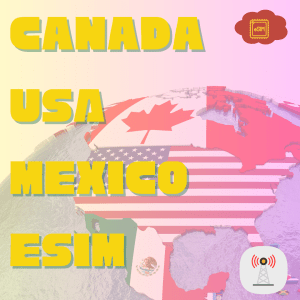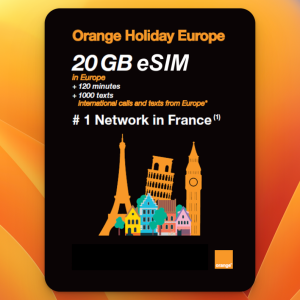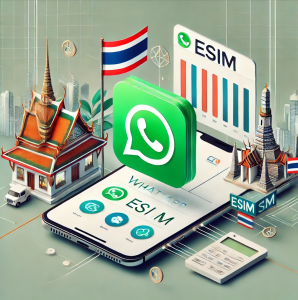eSIM in Thailand
Let’s take a look at your options for an eSIM in Thailand
Thailand is a popular destination that boasts some of the most diverse, delectable, and affordable dishes one could think of. In fact, there are numerous food vendors on the streets who will provide you with delicious food at a great price! So when in Thailand, you don’t need to worry about dedicating a high budget on meals. In addition, Thailand is comprised of some of the best beaches in the world, consisting of warm and clear water and stunning views, in addition to mesmerizingly beautiful marine life. This all renders Thailand a highly attractive tourist spot, which allows tourists to cross off a majority of requirements and attractions they tend to look for in a destination.
Not only does the country have a lot to offer, but all major local carriers support the use of an eSIM in Thailand as well!
Traveling to Thailand? Stay connected by purchasing an eSIM online!
eSIMs are easy to activate on your device, without the need for physically interacting with SIM cards. They also allow you to use a physical SIM at the same time – namely, your local line. Travel eSIMs are especially useful as you can acquire them digitally right before you travel, thus eliminating the need for individual SIMs or phones for your travel destination. You can also easily switch phones by registering your new device with your cellular network provider!
How do eSIMs work?
The way an eSIM works is that when you purchase one from a mobile network provider, you are sent a QR code via email, which you can scan and use to install a connection onto your phone. In other words, it is simply the virtual form of a SIM card, which you can easily install on your phone! You do not need to actually go to a mobile communications store and physically purchase a SIM card. In fact, in the wake of the pandemic, this contact-free method of acquiring an eSIM in Thailand is highly attractive to potential travellers!
Why purchase an eSIM in Thailand?
For starters, it is a great way to stay connected to your destination country. In this case, purchasing an eSIM in Thailand will allow you to maintain connection to communication services while you are abroad during your travels. If you were to use roaming data, you could be charged high fees. Secondly, they are very easy to acquire and you do not need to physically interact with any mobile service provider of an eSIM in Thailand, keeping your travels as streamlined as possible!
Local Carriers
AIS (1-2- Call, you! Mobile)

AIS (Advanced Info Service Public Company Limited) is the largest 2G/3G network with a 50% market share in Thailand, and is part of the SingTel Corporation which also owns Optus in Australia and SingTel in Singapore.
Surprisingly, AIS was the last major provider to launch 4G/LTE in 2016 on the 1800 and 2100 MHz bands (B3, B1), partly marketing it as “4.5G” or LTE Advanced. It covered 80% of the population in 2017 and is competitive to both True and dtac. 5G was recently launched on 2600 MHz. AIS’s prepaid package is often dubbed “1-2-Call”.
Company history
The company is controlled by Intouch Holdings (formerly Shin Corporation), headed by Temasek Holdings, a Singapore government-owned agency. AIS was officially listed on the Stock Exchange of Thailand on November 5th, 1991. As of 23 December 2011, Intouch holds 40.45% of company shares, and Singapore Telecommunications – together with the Thai Trust Fund and OCBC Nominees – holds a 23.32% stake.
Temasek bought the AIS brand through the 2006 acquisition of the Shin Corporation from ousted former Prime Minister Thaksin Shinawatra. In February 2014, however, in a conflict between the People’s Democratic Reform Committee (PRDC) and Shinawatra, the PDRC called for a boycott of AIS, wrongly believing it to be owned by the Shinawatra family!
This carrier supports the use of an eSIM in Thailand.
Check out their local prices and coverage (in THB)

dtac
 dtac, for Total Access Communication, is Thailand’s 3rd largest network. It’s partly owned by the Telenor group from Norway and it is the network that owns the largest wireless bandwidth in the country. Its prepaid package is called “Happy”.
dtac, for Total Access Communication, is Thailand’s 3rd largest network. It’s partly owned by the Telenor group from Norway and it is the network that owns the largest wireless bandwidth in the country. Its prepaid package is called “Happy”.
4G/LTE started in 2014 on 2100 MHz (B1) in Bangkok only and was further expanded in 2015 to Phuket and Pattaya and an additional 40 cities nationwide. In 2015, 4G/LTE was launched in the metro Bangkok area, mostly on the 1800 MHz (B3) frequency, which is more commonly used internationally. In June 2018, DTAC began offering 4G+ on the rare 2300 MHz frequency through a deal with TOT. 5G is intended to be launched on 700 MHz.
This carrier supports the use of an eSIM in Thailand.
Check out their local prices and coverage (in THB )

TrueMove
TrueMove is Thailand’s 2nd largest and most heavily advertised network in the country. It is part of the larger True Corp. conglomerates, owned by the CP Group (the biggest retailer, which owns all 7-Eleven and Tesco stores in Thailand).
They were the first provider in Thailand to bring 4G/LTE on the 2100 MHz (B1) to the country. Their 4G/LTE coverage is, so far, the best in the country, and it rose from 80% to 96% by the end of 2016. In 2015, coverage on the 1800 MHz band (B3) was added for 4G/LTE as well as 850 and 900 MHz (B8) in 2016. 5G was launched in 2020 on 2600 MHz (n41).
This carrier supports the use of an eSIM in Thailand.
Check out their local prices and coverage (in THB)

eSIM2Fly Roaming SIM
 So how does a roaming eSIM compare with local eSIMs?
So how does a roaming eSIM compare with local eSIMs?
Local SIMs are charging about $2.12 per GB. The price per GB on SIM2Fly is $3.10 per GB on the first package and then $2.50 for add-on packages. This makes the eSIM2Fly roaming SIM competitive with the local eSIMs in price per GB, and another great option for an eSIM in Thailand!












